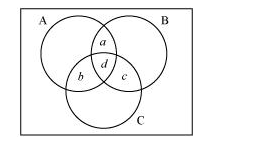In a survey of 60 people, it was found that 25 people read newspaper H, 26 read newspaper T, 26 read newspaper I, 9 read both H and I,11 read both H and T, 8 read both T and I, 3 read all three newspapers. Find:
(i) the number of people who read at least one of the newspapers.
(ii) the number of people who read exactly one newspaper.
Let A be the set of people who read newspaper H.
Let B be the set of people who read newspaper T.
Let C be the set of people who read newspaper I.
Accordingly, $n(A)=25, n(B)=26$, and $n(C)=26$
$n(\mathrm{~A} \cap \mathrm{C})=9, n(\mathrm{~A} \cap \mathrm{B})=11$, and $n(\mathrm{~B} \cap \mathrm{C})=8$
$n(\mathrm{~A} \cap \mathrm{B} \cap \mathrm{C})=3$
Let $U$ be the set of people who took part in the survey.
(i) Accordingly,
$n(\mathrm{~A} \cup \mathrm{B} \cup \mathrm{C})=n(\mathrm{~A})+n(\mathrm{~B})+n(\mathrm{C})-n(\mathrm{~A} \cap \mathrm{B})-n(\mathrm{~B} \cap \mathrm{C})-n(\mathrm{C} \cap \mathrm{A})+n(\mathrm{~A} \cap \mathrm{B} \cap \mathrm{C})$
= 25 + 26 + 26 – 11 – 8 – 9 + 3
= 52
Hence, 52 people read at least one of the newspapers.
(ii) Let a be the number of people who read newspapers H and T only.

Let b denote the number of people who read newspapers I and H only.
Let c denote the number of people who read newspapers T and I only.
Let d denote the number of people who read all three newspapers.
Accordingly, $d=n(\mathrm{~A} \cap \mathrm{B} \cap \mathrm{C})=3$
Now, $n(\mathrm{~A} \cap \mathrm{B})=a+d$
$n(B \cap C)=c+d$
$n(\mathrm{C} \cap \mathrm{A})=b+d$
$\therefore a+d+c+d+b+d=11+8+9=28$
$\Rightarrow a+b+c+d=28-2 d=28-6=22$
Hence, $(52-22)=30$ people read exactly one newspaper.
Click here to get exam-ready with eSaral
For making your preparation journey smoother of JEE, NEET and Class 8 to 10, grab our app now.
